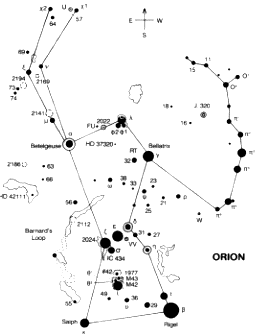
- Yjesite
-
i/e rregjistruar


- Reputacioni
- 0
Yjesite
nese ka mundesi mund te me jepni informacion per yjesite dhe konstelacionet???? ju faleminderit!!
-
What Are Constellations?
The constellations are totally imaginary things that poets, farmers and astronomers have made up over the past 6,000 years (and probably even more!). The real purpose for the constellations is to help us tell which stars are which, nothing more. On a really dark night, you can see about 1000 to 1500 stars. Trying to tell which is which is hard. The constellations help by breaking up the sky into more managable bits. They are used as mnemonics, or memory aids. For example, if you spot three bright stars in a row in the winter evening, you might realize, "Oh! That's part of Orion!" Suddenly, the rest of the constellation falls into place and you can declare: "There's Betelgeuse in Orion's left shoulder and Rigel is his foot." And once you recognize Orion, you can remember that Orion's Hunting Dogs are always nearby. Then you might recognize the two bright stars in the upper and lower left of the photograph as Procyon in Canis Minor and Sirius in Canis Major, respectively.
When you look in a sky atlas, you might see diagrams like this:

Obviously, this is very different from the photo above. This type of schematic draws the stars as different sizes to represent different brightnesses. In addition, there is a standard way to connect the stars that allow astronomers and others who use charts like this to quickly tell what they are looking at. In almost every star atlas, you will see Orion drawn with these same lines.
You might also notice that every star on the chart is labeled (sorry that it came out a little blurry). This chart is useful because it accurately shows the relative positions of the stars in this small region of the sky. In addition, other things besides stars are also labeled on the chart. For example, Barnard's Loop on the left and M42 in the bottom middle are pointed out. Barnard's Loop is a cloud of faintly glowing gas, which can't be seen without a telescope. M42 is the Great Orion Nebula and it is the red splotch in Orion's Sword in the photo above.
OK, so we know the constellations are helpful for remembering the stars, but why would people want to do that (besides astronomers, that is)? After all, I said at the beginning that farmers invented the constellations. Why did they do that? Was it for some religious purpose?
Yes and no. Around the world, farmers know that for most crops, you plant in the spring and harvest in the fall. But in some regions, there is not much differentiation between the seasons. Since different constellations are visible at different times of the year, you can use them to tell what month it is. For example, Scorpius is only visible in the northern hemisphere's evening sky in the summer. Some historians suspect that many of the myths associated with the constellations were invented to help the farmers remember them. When they saw certain constellations, they would know it was time to begin the planting or the reaping.
This dependence on the sky became a strong part of many cultures. Perhaps there is something about the mystery of the night sky that makes people want to tell stories about the constellations. The picture at the left is an ornate star chart printed in 1835. Like the others, it shows the great hunter Orion. In this one, he is holding a lion's head instead of his traditional bow or shield. He has an eager look in his eye as he stalks Taurus, the Bull. Behind him, his faithful dog, Canis Major, is chasing Lepus, the Hare. Compare this picture to the photo near the top of the page. They are at about the same scale and they show the same stars.
The constellations have changed over time. In our modern world, many of the constellations have been redefined so now every star in the sky is in exactly one constellation. In 1929, the International Astronomical Union (IAU) adopted official constellation boundaries that defined the 88 official constellations that exist today.
burimi: http://www.astro.wisc.edu
per me shume:
en.wikipedia.org/wiki/Lists_of_stars_by_constellation
en.wikipedia.org/wiki/Constellation
www2.potsdam.edu/islamma/phys335constellations.htm
Scroll






